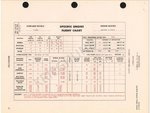Perhaps someone could shed some light about this:
Packard Merlin V-1610-3* was providing, according to the 'American Hundred Thousand' book, 1600 HP WER at 15,600ft, yet the MIL rating was 1490 HP at only 13,750 ft. All for low blower. It was providing 1330 HP at 29kft WER, while MIL rating was 1210 at 25,800ft (all for high blower).
Now, from what I've learned here at other places, maximum WER was possible at altitudes lower than maximum MIL (for same RPM blower position). Is the book wrong, or Sir Hooker was a true magician?
*edited: title was 1610, not 1650
Packard Merlin V-1610-3* was providing, according to the 'American Hundred Thousand' book, 1600 HP WER at 15,600ft, yet the MIL rating was 1490 HP at only 13,750 ft. All for low blower. It was providing 1330 HP at 29kft WER, while MIL rating was 1210 at 25,800ft (all for high blower).
Now, from what I've learned here at other places, maximum WER was possible at altitudes lower than maximum MIL (for same RPM blower position). Is the book wrong, or Sir Hooker was a true magician?
*edited: title was 1610, not 1650
Last edited:

